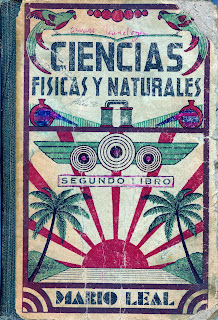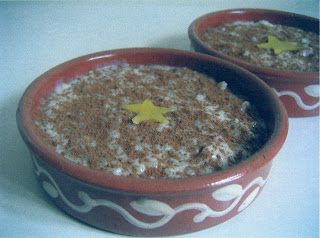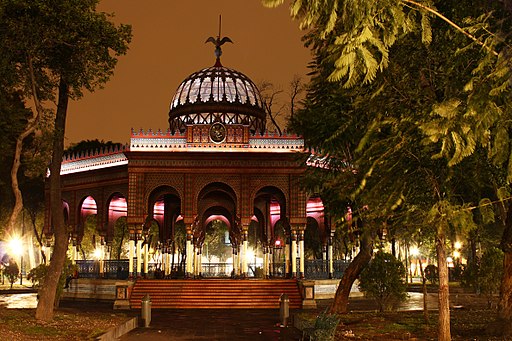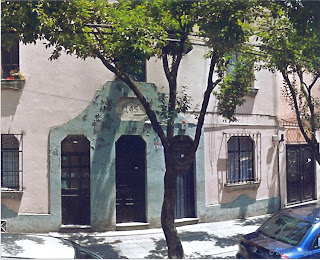 |
| CC courtesy of Eva Luedin on Flickr |
Decisions to move are not made lightly, especially when a large family and a great distance is involved. My parents thought long and hard about leaving Chicago, where my mother had been born and lived all her life, and transplanting our roots to Mexico City in early 1964.
The trip to Mexico took about a week. My father, the sole driver in the family, was the captain of our station wagon-cum-ship, and my mother was the designated navigator. We four little girls, ages 2 through 9, had a job, too. As the dutiful passengers on this journey, we were to sit side-by-side in the back bench seat and enjoy the ride.
My father spent a couple of weeks building a large, lidded box to fit the carrier on top of our 1962 Ford Falcon station wagon, and he painted it pale yellow to match the car. Inside, he and my mother packed our clothes, dishes, photo albums, and special collectibles that were dear to my mother. My grandmother, Alice (McGinnis) Schiavon, had died the year before of complications from diabetes, and my mother made sure to bring along things that reminded her of her beloved late mother.
My mother used her creative talents to sew a set of cream-colored curtains for the windows, to shelter us from the strong sun and to give us some privacy when we pulled over to the side of the road to rest. She was so proud of them. We all thought we had the best-looking car a family could have.
My mother also sewed cloth bags for each of us children, into which she placed books, puzzles, road games, activity books, and other surprises. She did this whenever we went on long road trips, and we looked forward to receiving the surprise bags, never knowing what treasures they would contain for our journey.
For this special trip, we received extra books. Mine included Little Women by Louisa May Alcott, The Five Little Peppers and How They Grew by Margaret Sidney, and the first of many Nancy Drew mysteries, The Secret of the Old Clock, by Carolyn Keene. I tucked another book into my bag: a slim pocket size English-Spanish dictionary. It was a going-away gift from one of my classmates in Mrs. Prokopeak’s fourth grade class at Saint Philip Neri School.
We had a large cooler filled with ham and cheese sandwiches, milk, and other snacks. It sat in the back seat, in the middle so my two youngest sisters could put their short little feet on top, and it came in handy for lots of games of tic-tac-toe and Old Maid cards.
Besides a bundle of large road maps she kept up in the front seat, my mother carried something else that would have been a bit unusual for a long road trip. She took the Lady Plate, a stunning, very large French porcelain plate that she and my grandmother Alice had bought on their trip to Europe in 1950. After making its first appearance in the Schiavon family antiques gallery, the Lady Plate graced my grandmother’s living room for many years until she gave it to my mother just before she died.
My mother wrapped her treasure carefully in thick blankets and held it on her lap during the entire trip. To this day, I still do not know how she managed to keep it intact all the way down to Mexico and back again to California some years later.
My father, understanding my mother’s sentimental attachment to this reminder of her mother, checked his maps and planned our route to Mexico via the Pan-American Highway, entering Mexico through the U.S. border town of Laredo, Texas, and traveling through the Mexican cities of Nuevo Laredo, Monterrey, Ciudad Victoria, Pachuca, and eventually into the capital, Mexico City, also known as the Federal District. The road was said to be wider in many places, safer, and better maintained than most – a good bet for getting one’s wife, squirmy children, and fragile cargo to their final destination happy and in one piece.
 |
Map of the Pan-American Highway, also known
as the Inter-American Highway.
Courtesy Wikipedia, Creative Commons |
To take advantage of time, my father drove from very early in the morning until late afternoon, so we would have ample time to play and wear ourselves out at the motels along the way. Between asking our parents if we were “there” yet, we called out state license plates and every bridge we crossed. We read the Burma Shave signs on the side of the roads in the South. As we crossed the border into Mexico, we marveled at the jungles we passed through and squealed with delight at the wild monkeys at some of the rest stops.
Although this highway was better than most in Mexico, it could be dangerous in places. We traversed many a windy road, climbing mountains thousands of feet high, my mother calling out the signs and hazards along the way: “Sharp curve ahead,” “Semi-truck coming up on your left,” “Narrow lane ahead,” and “Avalanche area ahead.” This last warning was the worst one. My mother would look back at us and repeat it, “Avalanche area ahead – Shhhhh!” She wanted us to remain silent while my father tried to concentrate on the road. It was not always easy for us to keep quiet (especially when we were fighting), but we did our best, holding our breath until we were out of the danger zone. I can’t speak for my sisters, but I was afraid that if we so much as let a peep out of our mouths, the sound waves of our voices might trigger a loose rock, causing more to come tumbling down on top of us.
It may not have been too far from the truth, for we did see a number of piles of loose rock on some of the higher passes.
We also saw quite a few disabled cars on the road. A most sobering sight was the occasional wooden crucifix that appeared here and there on the road, enshrined in pictures and flowers as memorials of other travelers who had not gotten to their intended destination but to their final resting place instead. Whenever we saw this, my mother would lead the family in making the sign of cross and saying a prayer for the departed.
We did the same whenever we heard sirens, as these usually meant an ambulance passing by. As we neared Mexico City, we heard a gaggle of screaming sirens, and my mother called back to us to get ready to bow our heads and make the sign of the cross for whomever was inside the ambulance. Imagine our surprise when the parade of sirens turned out not to be ambulances but a convoy carrying the President of Mexico himself, Adolfo Lopez Mateos!
The President waved at our car as his limousine passed us but dropped his jaw when he saw six gringos bowing their heads and blessing themselves in unison! My father recognized him instantly and had quite a funny story to tell the relatives when we arrived at my grandmother’s home in Mexico City later that day.
It was an emotional arrival. My father’s four brothers and five sisters and their families were all there, except for my Uncle Carlos, who by then was living in Chicago with his own wife and family. We had been to Mexico once or twice before on summer vacations, but we could not believe what a large family we had – and every single one of them seemed to be hugging us, crying and speaking to us in Spanish. My sisters and I could not understand what they were saying yet, but it didn’t matter. We already felt right at home.
Copyright © 2013 Linda Huesca Tully
Like this:
Like Loading...











